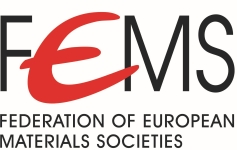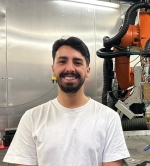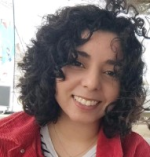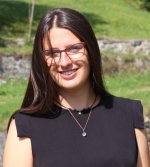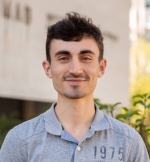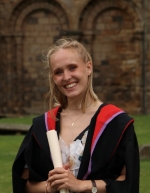Meet the 2024 FEMS Master Thesis Award finalists
The 2024 FEMS Master Thesis Award will take place on Wednesday 17 July during FEMS Junior EUROMAT 2024 (14:45 - Main Room, Mercure Manchester Picadilly Hotel). The finalists, all winners of their national finals, will give a 10-minute presentation and answer the judging panel's questions to become the overall winner.
Meet the 2024 finalists
Bernardo Luís Moreira Ribeiro (SPM)
Bernardo L Ribeiro completed his master’s in Materials Engineering, specialising in Metallurgy, in July 2023 at the Faculty of Engineering of the University of Porto (FEUP). His master's dissertation focused on high-throughput screening of refractory high-entropy alloys, through the combination of thermodynamic simulation and advanced characterisation techniques for microstructural and mechanical characterisation. During his time at FEUP, he had the opportunity to represent NucMMat (Academic Nucleus of Metallurgy and Materials of FEUP) as its president from 2021 to 2022. He works in the field of Engineering Sciences and Technologies with an emphasis on Materials Engineering, where he has developed several works focused on the optimisation of additive manufacturing processes (DED) and the mechanical and microstructural characterisation of nickel superalloys, metal matrix composites, and high-entropy alloys.
In-situ alloying by Direct Energy Deposition for high-throughput screening of RCCA/RHEAs compositions
The development of novel Refractory High Entropy Alloys (RHEAs) provides the possibility to overcome the inherent limitations of Ni-based superalloys, particularly regarding combustion systems used in aerospace and aviation applications. In this dissertation, the in-situ alloying by Direct Energy Deposition (DED), combined with thermodynamical simulations (CALPHAD), is presented as a high-throughput screening methodology to gather immense new information on RHEAs and RCCAs based on the MoNbTaW system. Furthermore, the relationship between process parameters, alloy composition, microstructure, and mechanical properties was established.
Marios Sotiriou (HMS)
Marios is a doctorate student at the Department of Mechanical Science and Engineering at the University of Illinois at Urbana-Champaign, working on atomistic modelling of dislocations in topological insulators. His research interests include atomistic modelling and simulations, condensed matter physics, computational thermodynamics and kinetics, and solidification.
Modelling microstructural evolution of austenitic stainless steels in additive manufacturing
Modelling of the heat transfer and microstructural evolution of austenitic stainless steels in Additive Manufacturing (AM), within an Integrated Computational Materials Engineering (ICME) framework. Development of an in-house heat transfer model in ABAQUS, considering non-equilibrium thermophysical properties and the effect of metal powder. Design of a CALPHAD modelling methodology of the microstructural evolution of solidification and solid-state transformations upon thermal cycling, to consider the variance in solidification type, cooling rate and growth mechanism.
Inès Addi (SF2M) - 2nd Place
I am currently a PhD student at the Institute for Civil and Mechanical Engineering Research at Saint-Nazaire, where I am working on the plasticity of hexagonal materials in temperature. I obtained my two-year degree in Physics and Instrumentation in Saint-Nazaire in 2020, just after graduating from high school in 2018. During this training period, I had the opportunity to gain experience in a number of scientific fields, including electrical engineering, programming, thermodynamics, chemistry, and material sciences. My internship was conducted in a laboratory specialized in nuclear medicine in Nantes, where I worked on the electrodeposition of zinc in a solution buffered with citrate. Then in 2021, I obtained my Bachelor’s degree in Material Sciences in Poitiers, during which I had the opportunity to work on the preparation of samples for electron microscopy in Strasbourg. In 2023, I completed my formation course with the obtaining of my Master’s degree in high performance materials development in Poitiers. During my internships, I worked on optimizing the mechanical properties of superelastic titanium alloys by controlling the grain size in Nantes and on the engineering of grain boundaries in TWIP titanium alloys for enhanced mechanical properties, in Paris. These experiences, enabled me to investigate the relationship between material processing, microstructure and mechanical properties.
Grain boundaries engineering in TWIP Ti alloys for enhanced mechanical properties
The aim of the present study is to analyse the influence of grain boundaries on the initiation and the transfer of twins in a TWIP Ti-15Mo alloy, in order to further improve its mechanical properties. For this purpose, the analysis is carried out along two main research axes. A first axis concerns the influence of the energetic stability of the grain boundaries with the analysis of out-of-equilibrium and at equilibrium grain boundaries in the Ti-15Mo. The second axis concerns the influence of grain boundary chemistry with the design of Ti-15Mo-1.5Sn and Ti-15Mo-0.4O alloys by arc melting.
Sara Scolari (AIM) - 3rd Place
Sara graduated with Laude in Materials Engineering and Nanotechnology at Politecnico di Milano (December 2023) with a thesis focused on the valorisation of steelmaking byproducts, also achieving the title of PoliMi Ambassador in Green Technologies. In February 2024, she started her PhD in Mechanical engineering at Politecnico di Milano. She is interested in metallurgy, particularly ironmaking and steelmaking, with a specific focus on the possibility of improving the sustainability of the steel production by encouraging the recycling and reuse of the steel’s solid and gaseous wastes.
Agglomeration of integrated cycle steel plant by-products through several organic binders
Self-reducing briquettes are an opportunity to recirculate waste from steel production and promote the sustainability of the process. To ensure the desired mechanical and metallurgical properties of briquettes, consideration must be given to the particle size distribution of the powders, their water affinity and careful selection of the binder used. Arabic gum confers self-standing ability and increases the mechanical strength of fine aggregates. Coarse reducing agent slows the reduction kinetics and causes catastrophic swelling. It is also possible to replace expensive natural Arabic gum with a recycled solution while maintaining the same mechanical properties.
John Joy (SFMT)
John is a PhD student at Luleå University of Technology, specializing in the mechanical performance, tribology and bendability of fossil-free high-performance steel, closely connected with manufacturing processes. He completed his Master's in Material Engineering at Chalmers University of Technology, Sweden and conducted his thesis at Alleima AB, Sweden. His research contributions include studies on the mechanical behaviour and microstructure analysis of high entropy materials and the intermediate temperature embrittlement of nickel-based superalloys.
Deformation Behaviours in Alloy 718 And Medium-high Entropy Alloys
-
Investigated the underlying mechanisms behind the intermediate temperature embrittlement and identified high strain rate influence to rectify intermediate temperature embrittlement.
-
The study provides insights into the mechanisms of intermediate temperature embrittlement, including the roles of the Laves phase, dynamic strain aging (DSA), and oxidation.
-
Medium-high Entropy Alloys shows combination of extraordinary strength and elongation due to multi order twinning induced plasticity behaviour at cryogenic ,room temperature and high temperature .
Oliver Preuß (DGM) - Winner
Oliver Preuß studied Materials Science at the Technical University of Darmstadt, Germany. After investigating the mechanical properties of diamond coatings during his Bachelor's thesis, he started his Master's thesis in the field of dislocations in ceramics in 2021, under the supervision of Dr. Xufei Fang. Continuing this topic, he started a PhD on dislocation-based toughening in ceramics co-supervised by Prof Dr Jürgen Rödel and Dr Xufei Fang. Preuß attended 3 international (incl. USA and Japan) and 3 national conferences and was awarded “Editor’s Choice” for his first paper in the Journal of the American Ceramic Society. He also won three prizes in the ceramographic competition of the American Ceramic Society, including the Roland B Snow award for best-of-show. In his free-time, he practices luthiery and builds his own guitars.
Dislocation-Based Toughening in Single-Crystal KNbO3
The growing research interest in dislocation tuned functionality in ceramics is evident, with the most recent proofs of concept for enhanced ferroelectric properties, electrical conductivity, and superconductivity via dislocations. In this study, we focus on dislocation-tuned mechanical properties and demonstrate that, by engineering high dislocation densities (up to 1014 per m-2) into KNbO3 at room temperature, the fracture toughness can be increased by a factor of 2.8 compared to the reference. A strong interaction between the dislocations and the ferroelectric domains was found, whose effect on the toughness is ruled out by a high-temperature indentation experiment
Lluís Casabona Cendra (SOCIEMAT)
Lluís holds a dual degree in Physics and Chemistry from the Autonomous University of Barcelona (UAB). For his Nanoscience and Nanotechnology Master's thesis at UAB, conducted at the Institute of Materials Science of Barcelona (ICMAB-CSIC), he developed near-infrared phototransistors for flexible health monitoring applications using photosensitive organic semiconductor materials. He is currently a 'La Caixa Foundation' doctoral fellow at ICMAB under Prof Marta Mas-Torrent and Dr Carme Martínez-Domingo working on organic photodetectors, while also pursuing a Master's in Quantum Science and Technology at the University of Barcelona (UB). He enjoys teaching, outreach activities, nature, mountain hiking, and learning to dance electro swing.
Organic Field-Effect Transistors for Near-Infrared Light Detection
In this work, Organic Field-Effect Transistors (OFETs) have been fabricated and studied as Near-Infrared (NIR) photodetectors using a solution-processed Organic Semiconductor (OSC), named Y6. The study has shown the importance of thermal annealing in achieving crystallinity of the OSC, obtaining a high n-type field -effect mobility of 0.1 cm2V-1s-1 after annealing at 170C.The Y6 devices have also detected NIR light at 840nm, presenting a maximum photoresponsivity of 1.25 AW-1 at low incident optical powers. In summary, this work offers a method to develop NIR phototransistors by using low-cost fabrication techniques with roll-to-roll and large-area fabrication.
Savvas Papamakarios (HSSTCM)
Savvas holds a BSc in Physics from the University of Athens and an MSc from the University of Crete on Fabrication of 3D low THz metamaterials via 2-photos polymerization. He is a PhD candidate at the University of Athens where he studies the theoretical analysis and fabrication of active metamaterials for lasing applications, the development and synthesis of photoluminescent materials for lithography and the fabrication of metasurfaces using multiphoton lithography and holography. He is a member of the Non Linear Lithography group at IESL/Forth since 2011 and has presented on his research at national and international conferences. Savvas is also the recipient of the Master's student Fellowship from ITPO (Independent Power Transmission Operator) in Greece, for the best proposal on 'Energy and Environment' issues.
Fabrication of 3D low THz metamaterials via a 2-Photon Polymerization (2PP)
The high potential of combining metamaterials with 2PP is highlighted along with the development of novel designs based in Split Ring Resonators and their fabrication for a variety of low THz applications. In the main part, a metallo-delectric metamaterial that was rendered conductive using Selective Electroless Silver Plating is presented in order to trigger Electromagnetically Induced Transparency that can deal into delaying light applications. In the final part, three major applications are presented for biosensing, gas sensing and energy harvesting combining metamaterials and 2PP.
Emilia Russell (IOM3)
Emilia Russell is a 2nd year PhD student in the Department of Engineering at Durham University, currently investigating the impacts of mechanical strain on the electrical properties of 2-dimensional semiconductors. In her free time, she enjoys sailing and organising seminars from industry speakers with the Women’s Engineering Society at Durham.
Conduction Mechanisms and Electrostatic Properties of Disordered Media - a tool to aid scaling up of new electronic materials.
Using both simulational and practical methods to improve the understanding of the functionality of nanowire polymer composites. With this research into the effects of length, orientation and doping on percolation pathways through zinc oxide nanowires in poly(methyl methacrylate), we are one step closer to a new generation of printable electronics and smart windows.
